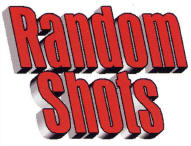 |
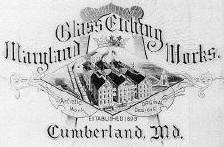
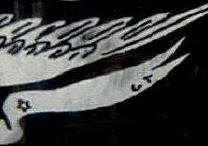
It doesn’t take pre-pro collectors very long before they start wondering where their treasured glasses originated and who made them. Answering the first question is relatively easy given that brand and owner information is often included on the label. The second question proves to be much more of a challenge but, as discussed below, a sizable proportion of them apparently were designed and produced by George Truog, owner and founder of the Maryland Glass Etching Works of Cumberland, MD.
Shot-glass blanks were manufactured by many companies in pre-Prohibition times and they came in wide range of sizes and styles. It’s almost impossible to determine who molded a particular glass and it’s likely that brand information was applied to whatever the etcher had on hand at the time. The fact that many identically-branded glasses survive in several different size variants supports this idea. The labels are distinctive, however, and in many cases highly artistic, and that’s made it possible to track the origins of many of the glasses back to Cumberland.
Cumberland and surrounding counties played home to many glass houses in the later part of the nineteenth century. In his early history of the area (The Glass Industry of Allegany County, Maryland), James Bishop tells us that George Truog established the Maryland Glass Etching Works in 1893 and it quickly became renowned for producing etched glassware of supreme quality that equaled or bettered that being imported from Europe. The techniques available for decorating glass were at the time fairly limited but the Maryland Glass Etching Works distinguished itself by producing acid-etched designs that both had a high degree of artistry and would withstand fading through continued use. Popular Truog designs included storks, flowers, and cherubs, and one could purchase complete sets of drinkware, jugs, and dishes all embellished with his naturalistic designs.
He also created a series of water glasses etched with patriotic or religious verses, such as the “America”, “Home Sweet Home”, and “Star Spangled Banner” glasses shown below. He also produced a very popular “Lord’s Prayer” glass, examples of which can be found in virtually any antique store, usually for $10 or less.
Although details of Truog’s operations are
sketchy, the artist signed many of his early glasses and that makes it
easy to attribute his handiwork. His signature is surprisingly difficult
to locate even when one is familiar with his work, but patience and a
practiced eye will often lead to the discovery of a tiny “GT” hidden in
one of the details at the right of the design. It’s the presence of a
signature that first identified Truog as being involved in shot-glass
production, although until recently his output was considered to be very
limited.
Among the first Truog shots to be identified as such were a series of
“Souvenir” glasses featuring a pair of clasped hands. A GT signature can
usually be found on the cuff of the hand on the right, although not all
glasses bear one. Truog produced at least two different designs in 1897,
one for the
Waynesboro, PA centennial and one for a
German Baptist
conference held in Frederick, MD. The obverse of such glasses features
dosage measure lines and the “Victor Liver Syrup” brand name within a
frosted crescent.
The glasses were sponsored by Dr. P. D.
Fahrney, an influential member of the German Baptist Church and also
owner of The Victor Remedies Company of Frederick. Victor Remedies went
on to back annual church gatherings in
Roanoke, VA in 1899 and
Bristol, TN
in 1905 as evidenced by shots bearing similar clasped-hand inscriptions.
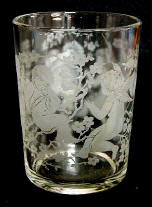 |
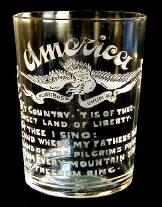 |
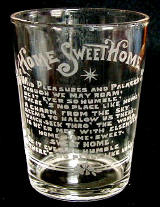 |
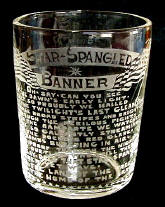 |